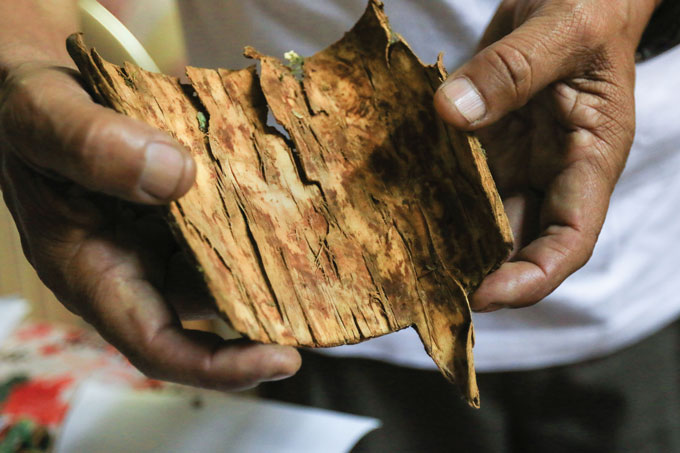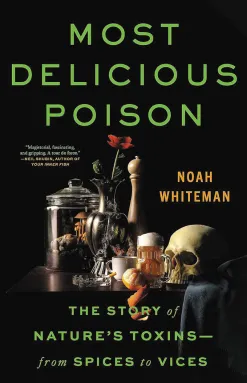
Quinine, commonly used to treat malaria, is a toxin derived from the bark of the cinchona tree (shown), native to South America.
CELSO ROLDAN/AFP via Getty Images
- More than 2 years ago

Most Delicious Poison
Noah Whiteman
Little, Brown Spark, $30
After his father’s unexpected death from alcohol use disorder in 2017, evolutionary biologist Noah Whiteman undertook a journey to understand how nature’s toxins affect the world. The result is his debut book, Most Delicious Poison: The Story of Nature’s Toxins — From Spices to Vices.
The book weeds through chemistry, evolution and world history to explore the origins of toxins and how humans have co-opted them for everything from medicines to spices to pesticides. “The chemicals in these products of nature are not a sideshow — they are the main event,” Whiteman writes, “and we’ve unwittingly stolen them from a war raging all around us.”
That tussle, part of what Charles Darwin called the “war of nature,” is the innovative ways plants and animals continuously evolve traits that one-up their predators or competitors. Many of the chemicals that we stock in our cabinets and pharmacies, for instance, originated in plants as deterrents against insects snacking on them, Whiteman points out. These chemicals act on our brains and bodies thanks to the surprising neurological similarities between insects and humans.
Whiteman, who studies how insects adapt to plant toxins, is a knowledgeable tour guide through this greenhouse of poisons and cures. And it is a greenhouse. Though people put some animal-made toxins to use, the plant derivatives steal the show.
Chrysanthemums with their insecticidal compound, pyrethrin, make an appearance in the book, as do terpenoid-wafting pines, calming chamomile and morphine-like water lilies. To tame the tangle of chemicals and their interactions, Whiteman dedicates each chapter to a couple of toxin classes and lays out their source in the natural world, their chemical mechanisms and historical context for their use by people.
Take tannins. They show up in a wide array of plants, including oaks, tea plants and grapes. Whiteman muses that these chemical compounds may protect plants by inhibiting the ability of microbes and herbivores to absorb nutrients. Tannins also bind to salivary proteins, resulting in the “rough, dry puckering sensation” that many people enjoy while sipping a glass of Cabernet Sauvignon. Humans have also long put the protein-binding properties of tannins to use in tanning animal hides for leather. For nearly 1,500 years, Europe and then its colonies relied on ink manufactured from tannin-rich oak galls for drafting important documents, including the Magna Carta and the Declaration of Independence.
Perhaps the most important role of toxins in the human world can be found in our pantries and medicine cabinets. Whiteman focuses on pharmacological heavyweights such as the antimalarial drug quinine, derived from the bark of the cinchona tree, and salicylates, such as aspirin and oil of wintergreen. Curare, cocaine and scopolamine demonstrate how we’ve wrangled these alkaloids into anesthetics. It’s one of many instances where Whiteman nods to Indigenous communities around the world that have been repeatedly exploited or gone uncompensated for their medicinal discoveries.
“It is no wonder that many countries in Latin America and elsewhere in the global tropics now have biopiracy laws that strictly regulate the export of natural products,” Whiteman notes.
Whiteman closes by examining how medieval Europe’s lust for spices catapulted the world into five centuries of geopolitical upheaval. The Columbian exchange, the Opium Wars and the founding of the East India Company are all pit stops along Whiteman’s exploration of how the pursuit of all things psychoactive and medicinal fueled European colonialism. The lasting consequences, Whiteman argues, include infringement on Indigenous rights, global biodiversity loss and the climate crisis.
The opioid epidemic and alcohol use disorder also loom large in the book. Here, Whiteman’s assertion that our use of toxins “walk[s] a knife’s edge between healing and harm” is loudest. His father haunts many of the personal anecdotes sprinkled throughout the 304-page read. Whether he’s recalling the toxicology report from his father’s autopsy or noting his family’s fondness for black pepper, Whiteman explores grief as much as he does science: “My attempt to grasp why [my father] died allowed me to identify and then draw together the many ways that nature’s toxins affect the world.”
Personal and well-researched, Most Delicious Poison has wide appeal, in part, as Whiteman points out, because indulging in nature’s toxins “is an essential part of what it means to be human.” So go ahead. Pour a cup of herbal tea, add some drops of lavender oil to the diffuser and enjoy this mind-bending read.
Buy Most Delicious Poison from Bookshop.org. Science News is a Bookshop.org affiliate and will earn a commission on purchases made from links in this article.






